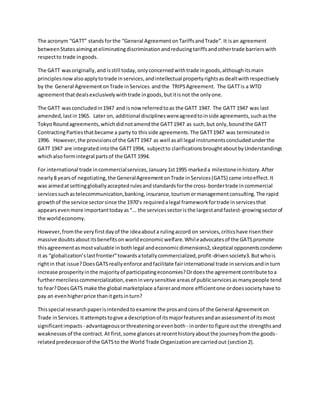Overall review of GATT
- 1. The acronym âGATTâ standsforthe âGeneral AgreementonTariffsandTradeâ.It isan agreement betweenStatesaimingateliminatingdiscriminationandreducingtariffsandothertrade barrierswith respectto trade ingoods. The GATT wasoriginally,and isstill today,onlyconcernedwithtrade ingoods,althoughitsmain principlesnowalsoapplytotrade inservices,andintellectual propertyrightsasdealtwithrespectively by the General AgreementonTrade inServices andthe TRIPSAgreement. The GATTis a WTO agreementthatdealsexclusivelywithtrade ingoods,butitisnot the onlyone. The GATT wasconcludedin1947 and isnow referredtoas the GATT 1947. The GATT 1947 was last amended,lastin1965. Later on, additional disciplineswereagreedtoinside agreements,suchasthe TokyoRoundagreements,whichdidnotamendthe GATT1947 as such,but only,boundthe GATT ContractingPartiesthatbecame a party to thisside agreements.The GATT1947 was terminatedin 1996. However,the provisionsof the GATT1947 as well asall legal instrumentsconcludedunderthe GATT 1947 are integratedintothe GATT1994, subjectto clarificationsbroughtaboutbyUnderstandings whichalsoformintegral partsof the GATT 1994. For international trade incommercialservices,January1st1995 markeda milestoneinhistory.After nearly8 yearsof negotiating,the GeneralAgreementonTrade inServices(GATS) came intoeffect.It was aimedatsettinggloballyacceptedrulesandstandardsforthe cross-bordertrade incommercial servicessuchastelecommunication,banking,insurance,tourismormanagementconsulting.The rapid growthof the service sectorsince the 1970âs requiredalegal frameworkfortrade inservicesthat appearsevenmore importanttodayasââĶ the servicessectoristhe largestandfastest-growingsectorof the worldeconomy. However,fromthe veryfirstdayof the ideaabouta rulingaccord on services,criticshave risentheir massive doubtsaboutitsbenefitsonworldeconomicwelfare.Whileadvocatesof the GATSpromote thisagreementasmostvaluable inbothlegal andeconomicdimensions2,skeptical opponentscondemn it as âglobalizationâslastfrontierâtowardsatotallycommercialized,profit-drivensociety3.Butwhois rightin that issue?DoesGATSreallyenforce andfacilitate fairinternational trade inservicesandinturn increase prosperityinthe majorityof participatingeconomies?Ordoesthe agreementcontribute toa furthermercilesscommercialization,eveninverysensitive areasof publicservicesasmanypeople tend to fear?DoesGATS make the global marketplace afairerandmore efficientone ordoessocietyhave to pay an evenhigherprice thanitgetsinturn? Thisspecial researchpaperisintendedtoexamine the prosandconsof the General Agreementon Trade inServices.Itattemptstogive a descriptionof itsmajorfeaturesandanassessmentof itsmost significantimpacts - advantageousorthreateningorevenboth - inorderto figure outthe strengthsand weaknesses of the contract.At first,some glancesatrecenthistoryaboutthe journeyfromthe goods- relatedpredecessorof the GATSto the World Trade Organizationare carriedout (section2).

